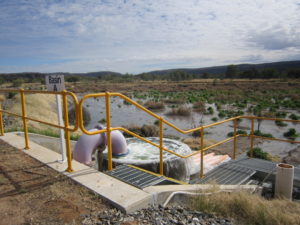MAR for sustainable cities
Stormwater use options for urban water supply
The Managed Aquifer Recharge and Stormwater Use Options (MARSUO) research project evaluated in depth:
- the quality of stormwater generated in the City of Salisbury
- the treatment requirements and risk management measures necessary to assure safe water quality for public open space irrigation
- third pipe reticulation to homes and for potential drinking water supplies.
The MARSUO project also evaluated and compared the economics of these options for a case study at Parafield in Salisbury, South Australia, accounting for basic assessments of environmental and social impacts.
The project conducted:
- focus groups and two web surveys to evaluate public acceptance of the different potential uses of stormwater
- an evaluation of biofilm in pipes of different materials was undertaken for mains water and stormwater to assess the likelihood of water quality changes and potential impacts on infrastructure maintenance
- studies of satellite sites in Australia and overseas were undertaken for comparative purposes, analysing stormwater quality and treatment requirements for drinking water use in relation to the Salisbury results.
Read multiple reports on the MARSUO research project on the Goyder website (Urban Water: Water Resources Mix for Adelaide), not all CSIRO led.
Recycled water MAR
CSIRO has a history of research collaboration with Water Corporation in Western Australia relating to recycled water MAR.
CSIRO provided detailed research to underpin Perth’s groundwater replenishment scheme. Groundwater replenishment is an innovative process where treated wastewater is further treated to drinking water standards and recharged into aquifers. The water is then stored or ‘banked’ in the ground and taken out some time later for further treatment and supply to a drinking water system.
Current research is focused on the performance of treated wastewater infiltration schemes across Western Australia. The research aims to understand the efficiency and long-term sustainability of water quality treatment provided by aquifers. Natural treatment of nitrogen and phosphorus is being assessed.
The Australian Water Recycling Centre of Excellence supported two research projects to support growth in recycled water MAR in Australia.
One project addressed three major knowledge gaps associated with recycled water MAR – clogging, water quality and economics.
The project undertook two detailed investigations that evaluated clogging and groundwater quality, in particular the fate of nitrogen, when treated wastewater was recharged using infiltration techniques via an infiltration gallery in Floreat, Western Australia and via soil aquifer treatment basins in Alice Springs, Northern Territory.
Infiltration galleries constructed at CSIRO’s Floreat site were used to study the infiltration of secondary treated wastewater. The research site is located in an unconfined calcareous sand aquifer and is typical of unconfined aquifers on the western Swan Coastal Plain of Western Australia.
Soil and water sampling, infiltration measurements and geophysical surveys were undertaken at an operational soil aquifer treatment scheme in Alice Springs, through collaboration with Power and Water Corporation, NT.
Laboratory column experiments and molecular biological analysis were used to evaluate the risk of aquifer clogging, the fate of various contaminants in aquifers, ways to enhance natural attenuation of contaminants and changes in microbial communities as a result of MAR with treated wastewater.
In addition, economics and lessons from experience were reported for a series of recycled water MAR case studies, including wastewater infiltration basins, infiltration galleries, soil aquifer treatment, groundwater replenishment or aquifer storage, transfer and recovery and aquifer storage and recovery.
Case studies report numerous benefits that MAR has to offer including replenishment of the groundwater resource, which can provide an alternative water supply option for a variety of uses, protect groundwater dependent ecosystems, prevent saline intrusion.
Reports:
Bekele, EB, Donn, MJ, Barry, KE, Vanderzalm, JL, Kaksonen, AH, Puzon, GJ, Wylie, J, Miotlinski, K, Cahill, K, Walsh, T, Morgan, M, McFarlane, D and Dillon, PJ (2015), Managed Aquifer Recharge and Recycling Options: Understanding Clogging Processes and Water Quality Impacts, Australian Water Recycling Centre of Excellence
Vanderzalm, JL, Dillon, PJ, Tapsuwan, S, Pickering, P, Arold, N, Bekele, EB, Barry, KE, Donn, MJ. and McFarlane, D. (2015), Economics and Experiences of Managed Aquifer Recharge (MAR) with Recycled Water in Australia, Australian Water Recycling Centre of Excellence
The second project investigated the economic and technical feasibility, and the environmental and social benefits, of recharging aquifers with recycled water at several sites in the Kwinana heavy industry precinct near Perth, Western Australia.
The project showed that recycled water infiltration ponds are cost effective, assuming that Kwinana industry’s current main source of non-potable water (shallow groundwater) becomes less secure and industrial demand continues to grow.
In addition, recharge to the Superficial Aquifer is beneficial for groundwater-dependent wetlands in the area.
Reports:
McFarlane DJ (ed) (2015), Recycled water for heavy industry and preventing sea water intrusion, Australian Water Recycling Centre of Excellence
GHD (2016), Kwinana managed aquifer recharge study MAR infrastructure concepts and cost estimates, GHD Report for CSIRO, February 2016
Soil Aquifer Treatment Basin, Alice Springs 2014
Photographer: Karen Barry
Soil Aquifer Treatment Basin, Alice Springs 2014
Photographer: Karen Barry

